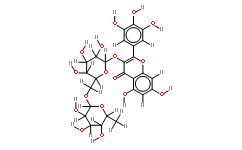Myricetin 3-O-rutinosideCAS# 41093-68-9 |

Quality Control & MSDS
Package In Stock
Number of papers citing our products

| Cas No. | 41093-68-9 | SDF | Download SDF |
| PubChem ID | N/A | Appearance | Powder |
| Formula | C27H30O17 | M.Wt | 626.52 |
| Type of Compound | N/A | Storage | Desiccate at -20°C |
| Solubility | Soluble in Chloroform,Dichloromethane,Ethyl Acetate,DMSO,Acetone,etc. | ||
| General tips | For obtaining a higher solubility , please warm the tube at 37 ℃ and shake it in the ultrasonic bath for a while.Stock solution can be stored below -20℃ for several months. We recommend that you prepare and use the solution on the same day. However, if the test schedule requires, the stock solutions can be prepared in advance, and the stock solution must be sealed and stored below -20℃. In general, the stock solution can be kept for several months. Before use, we recommend that you leave the vial at room temperature for at least an hour before opening it. |
||
| About Packaging | 1. The packaging of the product may be reversed during transportation, cause the high purity compounds to adhere to the neck or cap of the vial.Take the vail out of its packaging and shake gently until the compounds fall to the bottom of the vial. 2. For liquid products, please centrifuge at 500xg to gather the liquid to the bottom of the vial. 3. Try to avoid loss or contamination during the experiment. |
||
| Shipping Condition | Packaging according to customer requirements(5mg, 10mg, 20mg and more). Ship via FedEx, DHL, UPS, EMS or other couriers with RT, or blue ice upon request. | ||

Myricetin 3-O-rutinoside Dilution Calculator

Myricetin 3-O-rutinoside Molarity Calculator
| 1 mg | 5 mg | 10 mg | 20 mg | 25 mg | |
| 1 mM | 1.5961 mL | 7.9806 mL | 15.9612 mL | 31.9224 mL | 39.903 mL |
| 5 mM | 0.3192 mL | 1.5961 mL | 3.1922 mL | 6.3845 mL | 7.9806 mL |
| 10 mM | 0.1596 mL | 0.7981 mL | 1.5961 mL | 3.1922 mL | 3.9903 mL |
| 50 mM | 0.0319 mL | 0.1596 mL | 0.3192 mL | 0.6384 mL | 0.7981 mL |
| 100 mM | 0.016 mL | 0.0798 mL | 0.1596 mL | 0.3192 mL | 0.399 mL |
| * Note: If you are in the process of experiment, it's necessary to make the dilution ratios of the samples. The dilution data above is only for reference. Normally, it's can get a better solubility within lower of Concentrations. | |||||

Calcutta University

University of Minnesota

University of Maryland School of Medicine

University of Illinois at Chicago

The Ohio State University

University of Zurich

Harvard University

Colorado State University

Auburn University

Yale University

Worcester Polytechnic Institute

Washington State University

Stanford University

University of Leipzig

Universidade da Beira Interior

The Institute of Cancer Research

Heidelberg University

University of Amsterdam

University of Auckland

TsingHua University

The University of Michigan

Miami University

DRURY University

Jilin University

Fudan University

Wuhan University

Sun Yat-sen University

Universite de Paris

Deemed University

Auckland University

The University of Tokyo

Korea University
- Desacylsenegasaponin B
Catalog No.:BCX0697
CAS No.:163589-51-3
- Quercetin 3-O-[beta-D-xylosyl-(1->2)-beta-D-glucoside]
Catalog No.:BCX0696
CAS No.:83048-35-5
- Cavidine
Catalog No.:BCX0695
CAS No.:32728-75-9
- Polygalasaponin XXVIII
Catalog No.:BCX0694
CAS No.:176182-01-7
- N-benzyl-heptadecanamide
Catalog No.:BCX0693
CAS No.:883715-19-3
- N-(3-methoxybenzyl)-octadecanamide
Catalog No.:BCX0692
CAS No.:1429659-99-3
- 8,9-epoxy-3,10-diisobutyryloxythymol
Catalog No.:BCX0691
CAS No.:22518-06-5
- Farnesene
Catalog No.:BCX0690
CAS No.:502-61-4
- Koumidine
Catalog No.:BCX0689
CAS No.:1358-75-4
- Gentianose
Catalog No.:BCX0688
CAS No.:25954-44-3
- 3-Hydroxy-1,2-dimethoxy-anthraquinone
Catalog No.:BCX0687
CAS No.:10383-62-7
- Cassiaside C2
Catalog No.:BCX0686
CAS No.:1958039-40-1
- Cyclanoline
Catalog No.:BCX0699
CAS No.:18556-27-9
- Cauloside D
Catalog No.:BCX0700
CAS No.:12672-45-6
- Methylcantharidinimide
Catalog No.:BCX0701
CAS No.:76970-78-0
- Mussaenosidic acid
Catalog No.:BCX0702
CAS No.:82451-22-7
- Epirosmanol
Catalog No.:BCX0703
CAS No.:93380-12-2
- Endothalic acid
Catalog No.:BCX0704
CAS No.:145-73-3
- Ginsenoside Ra6
Catalog No.:BCX0705
CAS No.:1346522-89-1
- Methyl jasmonate
Catalog No.:BCX0706
CAS No.:1211-29-6
- 5-Hydroxy-2′,3,4′,7-tetramethoxyflavone
Catalog No.:BCX0707
CAS No.:19056-75-8
- Oroxylin A-7-glucoside
Catalog No.:BCX0708
CAS No.:36948-77-3
- Oleandrigenin
Catalog No.:BCX0709
CAS No.:465-15-6
- Digitoxigenin
Catalog No.:BCX0710
CAS No.:143-62-4
Shoot aqueous extract of Manihot esculenta Crantz (cassava) acts as a protective agent against paracetamol-induced liver injury.[Pubmed:31951477]
Nat Prod Res. 2021 Nov;35(22):4724-4728.
Manihot esculenta Crantz (Euphorbiaceae), known as cassava, is a widely cultivated plant, considered one of the main sources of food in the tropical and subtropical regions of Africa and Asia. The aim of the present study was the evaluation of the antioxidant and anti-inflammatory effects of cassava shoot aqueous extract (CSAE) on liver injury induced by paracetamol and investigation of its effect on hyperhomocysteinemia. CSAE was administered to male albino rats classified into seven groups: control, treated, and prophylactic groups. A significant reduction in liver enzymes, malondialdehyde, and homocysteine were observed when compared to the paracetamol group, together with an increase in paraoxonase-1. Histopathological and histochemical results indicated that CSAE effectively ameliorate these parameters. Two main flavonol glycosides, quercetin 3-O-rutinoside and kaempferol 3-O-rutinoside, in addition to a minor Myricetin 3-O-rutinoside, were identified in CSAE. CSAE showed a therapeutic potential against paracetamol-induced liver injury probably through antioxidant activity of its flavonol glycosides.


